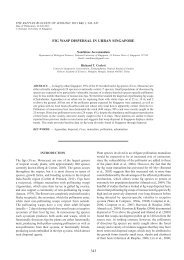1O257LF
1O257LF
1O257LF
Create successful ePaper yourself
Turn your PDF publications into a flip-book with our unique Google optimized e-Paper software.
© 2010 Dinosauria International Ten Sleep Report Series No. 1<br />
Fig 22 Left lateral views of diplodocid dorsal vertebrae. From left to right: Apatosaurus lousiae D9, CM 3018, Type (after Gilmore 1932);<br />
Diplodocus carnegii D8 (reversed) Type (Hatcher); Amphicoelias altus D 9? Type AMNH 5764 (reversed Osborn and Mook 1921); D. carnegii,<br />
D10 Type; D. longus, USNM 10865, D 10 (Gilmore 1932); Diplodocus longus AMNH 516 (Osborn 1904). Note the variability and off align<br />
position of neural spine in the tenth dorsals (arrows). AMNH 516 illustrates clearly the spinal modification needed for the tenth dorsal to<br />
fit against the sacral series. Figures not to scale<br />
Fig 23 Morrison sauropod sacra in ventral views.<br />
Top row from left to right: Apatosaurus lousiae Type CM 3018; Diplodocus longus AMNH 516 (Osborn 1904); “D. longus " Type"; Brontosaurus<br />
excelsus YPM 1980 Type; and “Atlantosaurus montanus”, Type, YPM 516.<br />
Bottom from left to right: Apatosaurus ajax Type; "Morosaurus" grandis, Type of Morosaurus impar, YPM 1900; Diplodocus carnegii Type; YPM<br />
1900; Camarasaurus supremus, AMNH 5761; and Camarasaurus species, AMNH 690.<br />
Note the distribution of ventral constriction and keeling of centra. Except for A. louisae, the diplodocids show this distinctive feature in<br />
contrast to the more rounded centra in camarasaurids. Sacral vertebrae in DQ-TY and DQ-BS are keeled. Figures not to scale<br />
30



